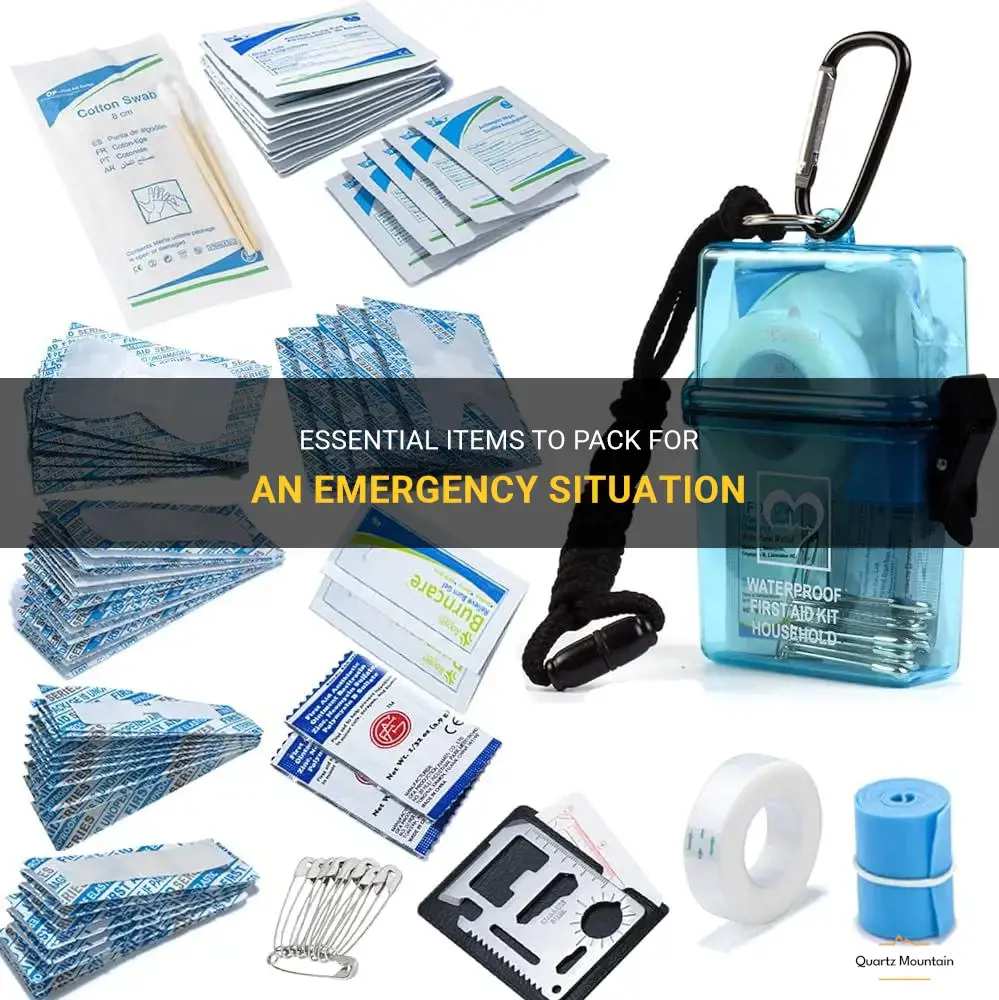
In times of crisis, being prepared can mean the difference between life and death. Whether you find yourself facing a natural disaster, a power outage, or any other emergency situation, having the essential items packed and ready can give you peace of mind and a greater chance of survival. From basic supplies like food and water to essential tools and first aid kits, this guide will outline the essential items that should be part of every emergency preparedness kit. So, grab your backpack and get ready to learn about the must-have items that can help you weather any storm.
| Characteristics | Values |
|---|---|
| Water | 1 gallon per person per day |
| Food | Non-perishable, easy-to-prepare items |
| Medications | At least a 7-day supply |
| First aid kit | Including bandages, gauze, and antiseptic |
| Flashlight | With extra batteries |
| Whistle | To signal for help |
| Battery-powered radio | To stay updated on emergency information |
| Cell phone charger | To keep your phone powered |
| Extra clothing | Including durable shoes and rain gear |
| Personal hygiene items | Toothbrush, toothpaste, and soap |
| Cash | In case ATMs and credit cards don't work |
| Important documents | Copies of IDs, passports, and insurance |
| Emergency contact information | Phone numbers of family and friends |
| Maps | In case you need to navigate |
| Sleeping bag or blanket | To stay warm |
| Shelter materials | Tent, tarp, or emergency blanket |
| Tools | Multipurpose tool, duct tape, and rope |
| Important family information | Names, birth dates, and Social Security numbers |
| Pet supplies | Food, water, leash, and carrier |
| Entertainment items | Books, games, and puzzles |
What You'll Learn
- What essential items should I include in an emergency kit?
- Are there any specific items I should pack in case of a natural disaster?
- How much food and water should I pack for each person in an emergency situation?
- Are there any specific medications or first aid supplies I should include in my emergency pack?
- What clothing and personal hygiene items should I pack for an emergency situation?

What essential items should I include in an emergency kit?
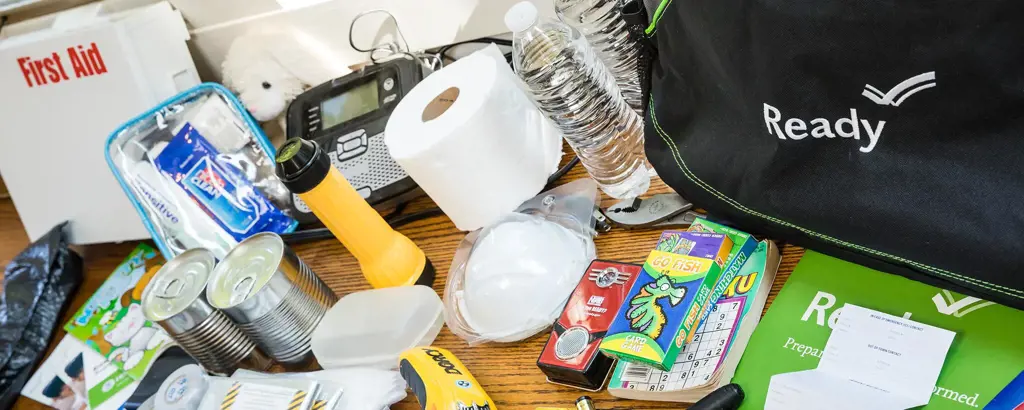
In case of an emergency, it is important to be prepared with a well-stocked emergency kit. This kit should contain essential items that can help you and your family survive until help arrives or normalcy is restored. While the contents of an emergency kit may vary depending on the specific situation and needs of your family, there are a few key items that should be included in every emergency kit.
- Water: The most important item to include in your emergency kit is water. Each person should have at least one gallon of water per day for drinking and sanitation purposes. It is recommended to have a three-day supply of water per person in your kit.
- Non-perishable food: Another essential item to include is non-perishable food that can provide sustenance during an emergency. Examples of such foods include canned goods, protein bars, and dried fruits. Make sure to pack a sufficient amount of food for each family member for at least three days.
- Medications: If you or any family member takes prescription medications, it is crucial to have a supply of these medications in your emergency kit. Make sure to regularly check the expiration dates of medications and replace them as needed.
- First aid kit: A well-stocked first aid kit is vital in case of emergencies. It should include bandages, antiseptic wipes, tweezers, pain relievers, and any specific medications or supplies needed for your family members' medical conditions.
- Flashlight and batteries: When the power goes out during emergencies, having a reliable flashlight and spare batteries is essential. Make sure to check the flashlight and replace the batteries periodically to ensure they are in working condition.
- Radio: A battery-powered or hand-crank radio can provide you with important updates and information during emergencies. Include spare batteries for the radio as well.
- Personal hygiene items: Basic personal hygiene items such as toothbrushes, toothpaste, soap, and toilet paper should be included in your emergency kit. These items can help maintain cleanliness and prevent the spread of diseases.
- Cash: During emergencies, ATMs may not be available, and electronic payment systems may be down. It is a good idea to have some cash on hand in small denominations as it may be useful for purchasing supplies or services.
- Important documents: Make sure to include copies of important documents such as identification cards, insurance policies, passports, and emergency contact information in your kit. Keep these documents in a waterproof container or bag.
- Additional items: Depending on your specific needs, you may also want to include additional items in your emergency kit such as a whistle, duct tape, matches, blankets, a multi-purpose tool, and extra clothing.
Remember to periodically check and update your emergency kit to ensure that all items are in good condition. It is also important to have a communication plan in place with your family members so that you can stay connected during emergencies. Being prepared with a well-stocked emergency kit can make a significant difference in your ability to cope with unexpected situations.
The Ultimate Packing List for a Memorable Trip to Drumheller
You may want to see also

Are there any specific items I should pack in case of a natural disaster?
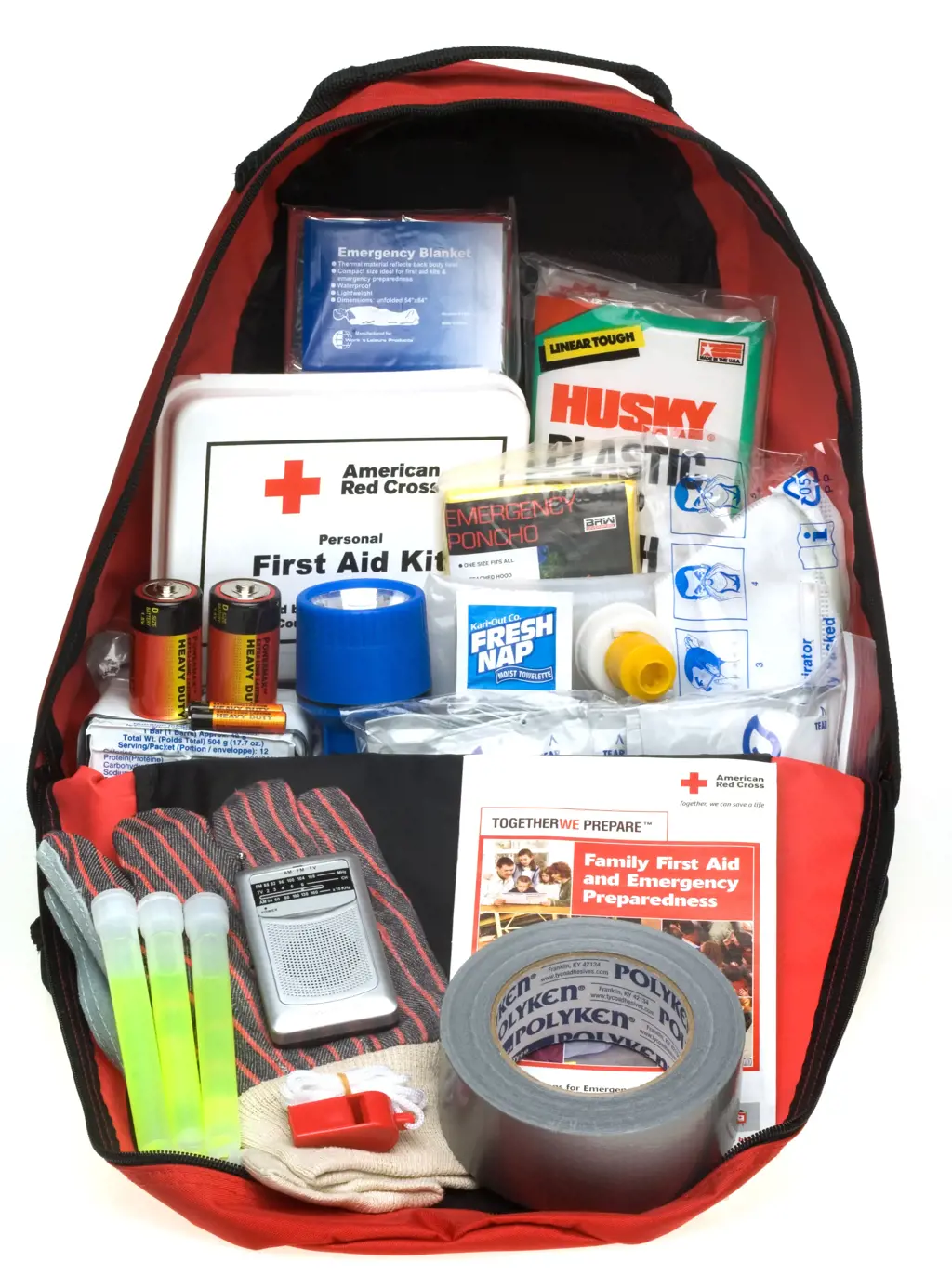
Natural disasters can strike at any time, often with little warning. When faced with an impending natural disaster such as a hurricane, earthquake, or flood, it is crucial to be prepared. One essential step in disaster preparedness is packing a disaster kit with specific items that will help you and your family survive and stay safe during and after the event. Here are some items that you should consider including in your disaster kit:
- Water: It is vital to stock enough water to sustain you and your family for at least three days. The general rule of thumb is to have one gallon of water per person per day.
- Non-perishable food: Pack a sufficient amount of non-perishable food items that can last you for several days. Canned goods, protein bars, and dried fruits are good options. Make sure to include a manual can opener as well.
- Medications: If you or any member of your family takes prescription medication, ensure you have an ample supply packed and ready to go. It is also a good idea to include over-the-counter medications such as pain relievers, stomach remedies, and first-aid supplies.
- Battery-powered or hand-crank radio: In case of a power outage, a radio can help you stay updated on the situation and receive emergency alerts. Make sure to include extra batteries or a hand-crank radio that doesn't require batteries.
- Flashlights and extra batteries: A reliable source of light is crucial during a natural disaster, especially at night. Pack multiple flashlights and plenty of spare batteries to ensure you have ample light when needed.
- Emergency contact information: It is important to have a written list of emergency contact information, including local authorities, relatives, and friends. Include both phone numbers and email addresses.
- Cash: During a natural disaster, ATMs and credit card systems may be offline or inaccessible. It would be wise to have some cash on hand to cover immediate expenses or emergencies.
- Copies of important documents: Make copies of essential documents such as identification cards, insurance policies, passports, and medical records. Store them in a waterproof container or folder for safekeeping.
- Sanitation supplies: Pack personal hygiene products such as toilet paper, wet wipes, hand sanitizers, and garbage bags. These items help maintain cleanliness and prevent the spread of diseases.
- Extra clothing and blankets: Pack extra clothes suitable for the weather conditions and include blankets or sleeping bags for warmth and comfort.
- Tools and supplies: Include a basic toolkit that consists of a wrench, pliers, a multi-purpose knife, duct tape, and a whistle. These tools can be invaluable in various situations and emergencies.
- Entertainment items: Natural disasters often come with periods of extended downtime. Pack some books, puzzles, playing cards, or other forms of entertainment to help keep your spirits up during these challenging times.
It is important to periodically check and update your disaster kit to ensure that all items are still in good condition and that nothing has expired. In addition, consider the specific needs and requirements of each member of your family, including infants, elderly individuals, and pets. By being prepared and packing the necessary items in advance, you can greatly increase your chances of surviving and comfortably weathering a natural disaster.
What Essentials to Pack for a Memorable Sleepover at Your Grandma's Place
You may want to see also

How much food and water should I pack for each person in an emergency situation?

Emergency situations can happen at any time, and it is crucial to be prepared with enough food and water to sustain yourself and your family during these times. The amount of food and water you should pack for each person will depend on various factors such as the duration of the emergency, the age and activity level of individuals, and their specific dietary needs. In this article, we will discuss how to determine the right amount of food and water to pack for each person in an emergency situation.
Firstly, it is essential to have a sufficient supply of water. The general recommendation is to store at least one gallon (3.8 liters) of water per person per day. This amount should cover drinking, cooking, and personal hygiene needs. However, if you live in a hot climate or have individuals with higher activity levels, you may need to increase this amount. It is also a good idea to have water purification tablets or a water filter in case your water supply runs out or becomes contaminated.
When it comes to food, a good way to estimate the amount needed is to consider the number of calories required per day. On average, an adult needs around 2000-2500 calories per day to maintain their energy levels. However, in emergency situations where you may be more physically active, you may need to increase this number. It is recommended to pack non-perishable, high-calorie foods such as granola bars, canned goods, and dried fruits and nuts. These items have a longer shelf life and provide the necessary energy.
The duration of the emergency is an essential factor to consider when determining the amount of food and water to pack. If you live in an area prone to natural disasters such as hurricanes or earthquakes, it is recommended to have a supply that can last at least 72 hours. This will provide you with enough time to wait for help or find alternative resources. In some cases, such as during a pandemic or a prolonged power outage, you might need to have a supply that can last several weeks or even months.
It is also important to consider the dietary needs of individuals in your family or group. If someone has specific dietary restrictions or allergies, make sure to pack foods that cater to their needs. For example, if someone is gluten intolerant, pack gluten-free options. Similarly, if someone requires a special diet due to a medical condition, ensure you have enough of the necessary foods and supplies.
Lastly, it is crucial to regularly review and update your emergency food and water supply. Check expiration dates and rotate items to ensure freshness. It is also a good idea to keep a list of the items in your emergency kit and update it as needed. Additionally, consider packing essential items such as a can opener, eating utensils, and cooking equipment.
In conclusion, packing enough food and water for each person in an emergency situation requires careful consideration of factors such as the duration of the emergency, individual needs, and calorie requirements. It is essential to pack non-perishable, high-calorie foods and have an adequate supply of water. Regularly review and update your emergency supplies to ensure they are fresh and ready to use. Being prepared with enough food and water will help ensure the well-being and survival of yourself and your loved ones during emergency situations.
Essential Items to Pack for Your Adventure on Survivor: A Comprehensive Guide
You may want to see also

Are there any specific medications or first aid supplies I should include in my emergency pack?
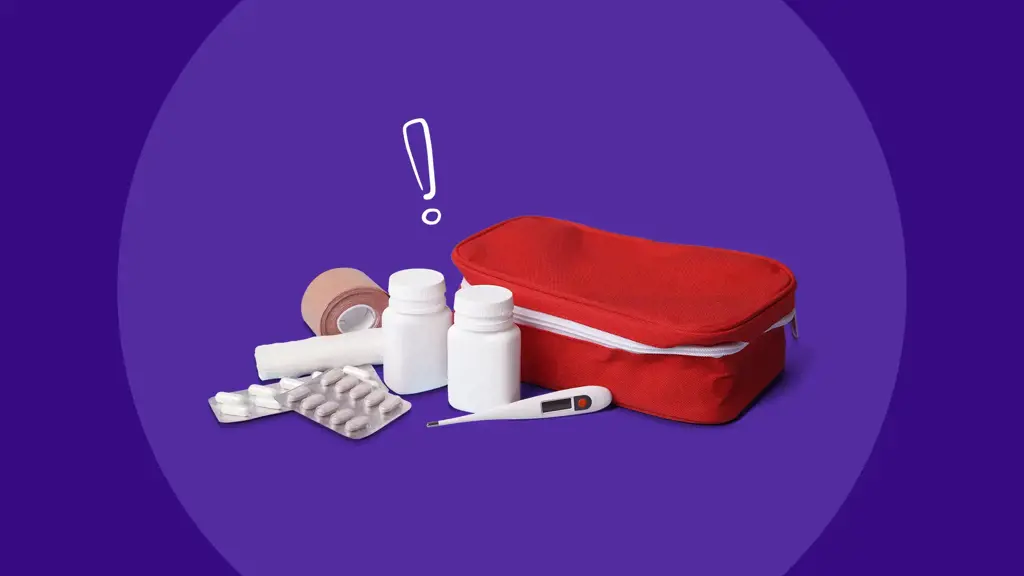
Emergencies can happen at any time, and being prepared with a well-stocked emergency pack can make all the difference in a critical situation. When assembling your emergency pack, it's essential to include specific medications and first aid supplies to handle a range of potential injuries and health issues. In this article, we will discuss some important medications and supplies that you should consider including in your emergency pack.
- Adhesive bandages: Adhesive bandages, also known as Band-Aids, are a must-have in any emergency pack. They are useful for covering small cuts, scrapes, and blisters to prevent infection and promote healing.
- Sterile gauze and medical tape: These supplies are essential for dressing larger wounds or applying pressure to control bleeding. Make sure to include a variety of sizes to accommodate different injuries.
- Antiseptic wipes or solution: Keeping wounds clean is crucial to prevent infection. Including antiseptic wipes or a small bottle of antiseptic solution can help disinfect wounds before dressing them.
- Pain relievers: In an emergency situation, it's common for individuals to experience pain or discomfort. Including over-the-counter pain relievers like acetaminophen or ibuprofen can provide relief until professional medical help is available.
- Allergy medication: An emergency can expose individuals to allergens or trigger severe allergic reactions. Including antihistamines like diphenhydramine can help manage allergic symptoms until medical assistance arrives.
- Prescription medications: If you or a family member require regular prescription medications, it's crucial to include an adequate supply in your emergency pack. Be sure to check the expiration dates periodically and replace them as needed.
- Disposable gloves: Protecting yourself and others from potential infections is important when providing first aid. Disposable gloves should be included in your emergency pack to ensure proper hygiene.
- Tweezers and scissors: These tools are handy for removing splinters, cutting tape or clothing, or other necessary tasks during an emergency.
- Oral rehydration salts: Dehydration can occur during emergencies, especially in cases of prolonged physical exertion or exposure to extreme temperatures. Including oral rehydration salts can help restore electrolyte balance in these situations.
- CPR mask: In the event of a cardiac arrest or respiratory emergency, a CPR mask can provide a barrier between the person administering CPR and the individual receiving it. This can help prevent the transmission of infectious diseases.
While the above items are essential to include in an emergency pack, it's important to assess your needs and customize your pack accordingly. For example, if you live in an area prone to snake bites or insect stings, including an emergency snake bite kit or an EpiPen for severe allergic reactions may be warranted.
It's also essential to regularly check and replenish your emergency pack to ensure that medications and supplies remain usable and within their expiration dates. Additionally, consider including a first aid manual or basic first aid instructions to guide you in handling different emergency situations.
In conclusion, when assembling your emergency pack, it's crucial to include specific medications and first aid supplies to handle a range of potential injuries and health issues. Adhesive bandages, sterile gauze, antiseptic wipes, pain relievers, allergy medication, prescription medications, gloves, tweezers, scissors, oral rehydration salts, and a CPR mask are all examples of items that should be considered. Customize your emergency pack based on your specific needs, and regularly check and replenish your supplies to ensure readiness for any emergency situation.
The Ultimate Guide on Packing for Your Dream Destination
You may want to see also

What clothing and personal hygiene items should I pack for an emergency situation?
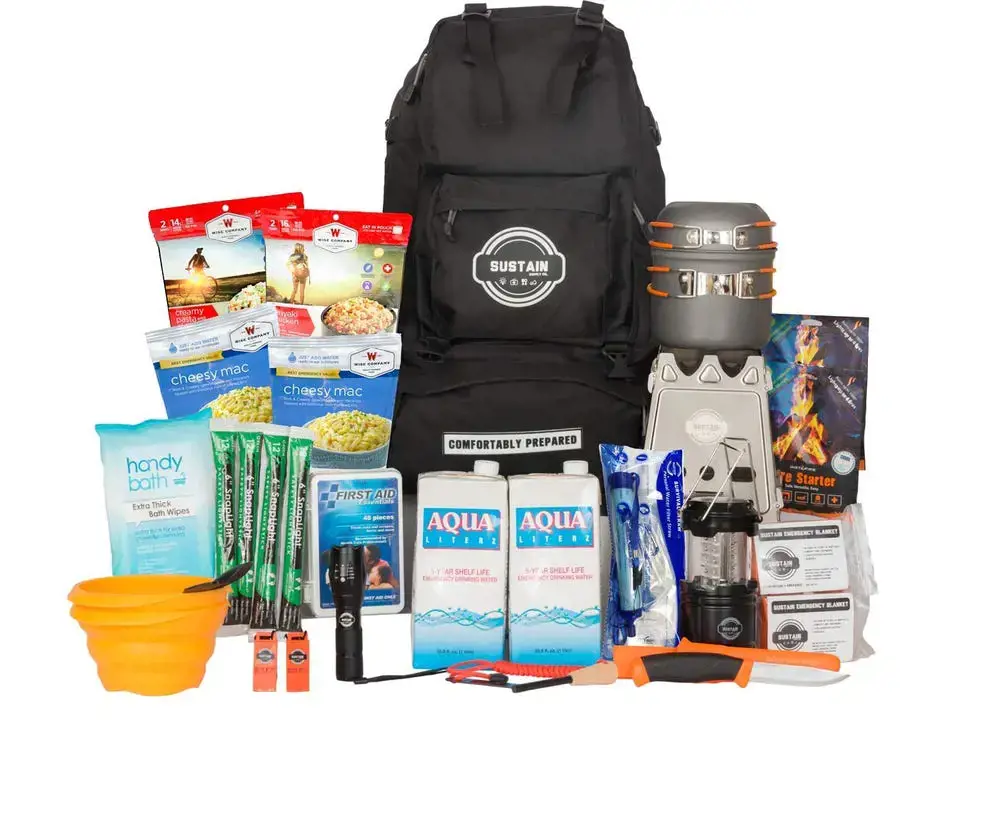
Emergencies can happen at any time, and being prepared can make all the difference in ensuring your safety and well-being. In addition to having food, water, and shelter supplies, it's essential to pack clothing and personal hygiene items for an emergency situation. Here are some key items to consider when putting together your emergency kit.
Clothing:
- Layers: Pack versatile clothing items that can be layered to accommodate changing weather conditions. This could include T-shirts, long-sleeve shirts, sweaters, and jackets.
- Outerwear: Have a waterproof or water-resistant jacket or poncho to protect yourself from rain and wind.
- Pants: Include long pants and shorts (if weather permits) that are durable and comfortable for various activities.
- Undergarments: Don't forget to pack extra underwear, socks, and bras to maintain hygiene and comfort.
- Footwear: Choose sturdy, comfortable shoes or boots suitable for walking long distances and providing protection.
Personal Hygiene Items:
- Toiletries: Include travel-sized toiletries such as toothpaste, toothbrush, soap, shampoo, and conditioner. Opt for biodegradable options if possible to minimize environmental impact.
- Hand sanitizer: Since water may not always be readily available, packing hand sanitizer is crucial for maintaining hand hygiene and preventing the spread of germs.
- Towel or wipes: Pack a microfiber towel or wet wipes to stay fresh and clean when access to traditional bathing facilities is limited.
- Feminine hygiene products: For individuals who menstruate, it's essential to include an adequate supply of tampons, pads, or menstrual cups.
- Prescription medications: If you take any medication regularly, ensure you have a sufficient supply in your emergency kit. Rotate them periodically to prevent expiration.
Additional Tips:
- Consider the climate: Tailor your clothing choices to the typical climate of your area or the potential weather conditions during an emergency. This may include packing hats, gloves, and scarves for cold climates or lightweight, breathable clothing for hot climates.
- Comfort and durability: Choose clothing that is comfortable, durable, and made from moisture-wicking materials to keep you dry and reduce the risk of chafing or irritation.
- Clothing for infants and young children: If you have infants or young children, pack extra diapers, wipes, formula, and baby food. Include clothing suitable for changing weather conditions and growth spurts.
- Storage: Store clothing and personal hygiene items in sealed plastic bags or waterproof containers to protect them from moisture and keep them organized.
Remember to periodically check and update your emergency kit to ensure that clothing and personal hygiene items are in good condition and properly stocked. Being prepared with the essentials can provide a sense of security during an emergency and help support your overall well-being.
Essential Items to Pack for Your Trip to L.A
You may want to see also
Frequently asked questions
When packing for an emergency kit, it is important to include essential items that can help you survive and be prepared for any situation. Some items to consider packing are non-perishable food items, such as canned goods and granola bars, a supply of water, a first aid kit, a flashlight with extra batteries, a portable radio, a multipurpose tool, an emergency blanket, personal hygiene items, extra clothing, and important documents such as identification and insurance papers. Additionally, it is recommended to have a supply of any necessary medications and a backup power source for electronic devices if possible.
The amount of food and water to pack in your emergency kit can vary depending on the size of your family and the length of time you are preparing for. It is generally recommended to have at least three days' worth of food and water per person. This includes one gallon of water per person per day for drinking and sanitation purposes. When it comes to food, it is best to pack non-perishable items that require little to no preparation. Canned goods, dry foods like rice and pasta, and granola bars are good options. Remember to periodically check and replace any expired food and water in your emergency kit.
In addition to the essential items mentioned earlier, there are other supplies you may want to consider packing in your emergency kit. These include extra cash, a copy of important documents (such as passports and birth certificates), a backup supply of prescription medications, a whistle to signal for help, basic tools like a wrench or pliers, a phone charger and power bank, a local area map, extra batteries for your electronic devices, a fire extinguisher, and any specific items needed for infants, elderly family members, or pets. It is also important to have a plan in place for communication and meeting up with family members in case of an emergency.







